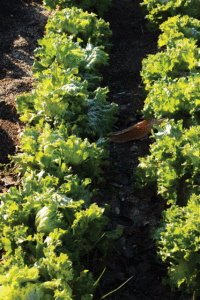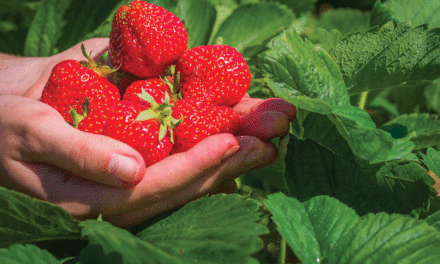
Lettuce and other leafy vegetables thrive with some shade coverage.
In a perfect world, we’d all have sunny, weed-free gardens but the truth is, it’s just not possible!
Perhaps your only possible garden site is along a woodsline, or your yard is surrounded by woods, or, your garden might consist of planting boxes on your patio.
While shade isn’t a deal breaker, you will have to take it into consideration.
How Shady is it?
If you know you have to deal with shade in your garden, the next step is to figure out how much shade you have by doing some “shade mapping.”
Before you get to planting, take a day to watch the sun patterns.
How many hours is your garden completely sunny, partially shaded, or fully shaded?
Peek out your window between chores and jot down some notes.
Be sure to note where the shadiest parts are if, like my garden, the sun is passing around something such as a tree or structure.
No time to sit and watch the sun rise and set?
There also are products that you can stick in your garden to give you a shade report after a 12-hour period.
Generally, though, you can follow the rule of thumb that a north-facing garden will likely be shady while south-facing will get the full brunt of the sun, barring any special land characteristics.
Shady Plants
Turning to the back of your seed packet, the shade scale is as follows: “Full Sun” is considered at least six hours, “Partial Sun” or “Partial Shade” is equal to at least four hours with a maximum of six hours of sunlight per day.
“Full Shade” is less than three hours of sun per day.
For some vegetables, a shady spot is even more preferable than full sun.
With less than four hours of sun, you can grow an enviable salad: Lettuce, kale, spinach, arugula and other leafy vegetables thrive with some shade coverage.
Root vegetables, such as potatoes, carrots, beets and garlic also do well with shade as well because while you may notice their leaf growth inhibited by less sun, their root growth will flourish.
Other shade lovers include broccoli or cauliflower as full sun can result in harsher taste, poor head formation and faster flowering.
Conversely, does your sunny garden not have enough shade?
You can create shade by planting shade needing plants next to a row of corn.
If you truly have nothing but sun, you could build your own structure and use shade cloth or layered nylon netting.
Sunny Plants
While several plants do grow just fine in shade, many larger vegetables such as watermelons, pumpkins, and squash likely won’t reach their full potential without a constant showering of sunshine.
Most often than not, full sun crops will be “low and late” if not in the ideal sun rate.
For growing peas and beans in shady spots, look for varieties labeled bush or dwarf to get a better chance at a good yield.
There’s a few tricks to try to invite more sunshine in.
If pruning isn’t possible or wouldn’t make a big impact, another trick to try is painting a light color such as white on fencing or other structures for the light to reflect from.
Another option is to plant sun loving vegetables such as tomatoes in a pot that can be moved to hit optimal shade.




